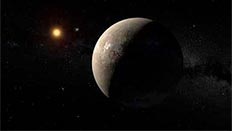Exoplanet discover
The challenges involved in detecting exoplanets
Look beyond our Solar System towards other stars, and we find evidence that planets, just like our own, orbit these stars. These planets, located outside our Solar system, are called exoplanets.
Over the last few decades thousands of exoplanets have been discovered - search through these discoveries. However, despite these seemingly large numbers, detecting exoplanets is far from easy!
On a clear night, even in large cities, it may be possible to see Venus, Mars, Saturn and Jupiter with the naked eye (depending on whether they lie above the horizon). These planets are visible as bright dots in the night sky, much like distant stars. However, planets don’t emit visible light themselves, but instead reflect the Sun’s light back towards us. Since planets do not produce their own visible light, as well as the fact that they are much smaller than stars, makes them very hard to detect.
 Neptune, Uranus and Pluto also reflect some of the Sun’s light back towards us, but as they are much further away from us and far smaller than Jupiter and Saturn, they are not visible with the naked eye. In fact, we require some of the best ground-based telescopes astronomers have to offer in order to directly image Pluto from the Earth - the image to the right shows a picture of Pluto taken by the Gemini 8m telescope located in Hawaii.
Neptune, Uranus and Pluto also reflect some of the Sun’s light back towards us, but as they are much further away from us and far smaller than Jupiter and Saturn, they are not visible with the naked eye. In fact, we require some of the best ground-based telescopes astronomers have to offer in order to directly image Pluto from the Earth - the image to the right shows a picture of Pluto taken by the Gemini 8m telescope located in Hawaii.
It is exceedingly difficult to image planets orbiting other stars this way - the nearest star to us is over 5,000 times further away from the Earth than Pluto is! Therefore, we require another approach to detect exoplanets.

